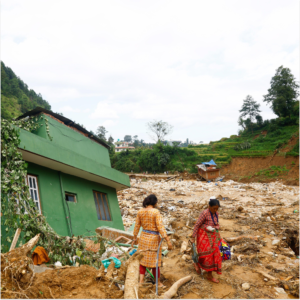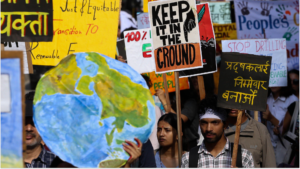16-year-old Binita Nepali explores how the climate crisis is affecting her homeland of Nepal

Women gather belongings from the ruins of their homes after the floods in Nepal, September 2024.
Picture by: Skanda Gautam | Alamy
Article link copied.
February 21, 2025
Floods, landslides and rising temperatures: How climate change is impacting Nepal
Global warming refers to the long-term warming of the entire planet. It has increased significantly over the last century as a result of the combustion of fossil fuels.
The issue affects every single country regardless of how much it has contributed to the problem. Global warming and the climate changes that result are impacting Nepal adversely, despite the country’s minimal contributions to its cause.
Harbingers’ Weekly Brief
Rising pollution is causing people to suffer from airborne illnesses such as heart disease and lung cancer. Other than people, the pollution also affects farming in Nepal, reducing soil fertility, meaning that the quality and quantity of crops will decrease. Alongside that, high temperatures cause plants and crops to dry out and die.
Nepal is a landlocked country, so rainfall is very important. However, the annual temperature increases are causing rainfall patterns to change, resulting in flooding and landslides,and threatening water resources.
According to Dhorje Tamang, principal of Shree Bal Vikas Samaj Basic School, Dandagaun, Kathmandu, global warming is negatively affecting Nepal due to uncontrolled pollution harming the atmosphere and sun rays striking the earth’s surface, disproportionately harming people, animals and the environment.
Similarly, Ranjit Tamang, a student at the school, stated that he feels much hotter now than he did previously, and attributed this to global warming.
Rapid unmanaged urbanisation, industrialisation and a lack of proper waste management are releasing a lot of greenhouse gases in the atmosphere, accelerating the problem.
Activities in developed countries – the main contributors to the climate crisis – have been linked to the melting of glaciers in Nepal. As a result, the country is dealing with a number of issues, including floods and landslides, which have claimed several lives and have been widely reported in national and international media.
This is also a problem because Nepal’s snow-capped mountains, including Everest, the world’s highest mountain, are a major source for revenue for the country’s tourism industry.
Global warming is threatening lives everywhere. But humans can adapt and change what they do and how they live, which may assist in coping with this challenge. For instance, increasing the use of electric vehicles for transportation, and developing factories and industries based on renewable sources of energy and located far from cities and villages.
Written by:

Contributor
Kathmandu, Nepal
Born in 2009 in Bajura, Binita Nepali studies in Budhanilkantha, Kathmandu, Nepal. She is interested in writing, teaching, singing and journalism and plans to study journalism in the future. She is part of our Nepali Newsroom’sIntermediate group and writes about social issues and human rights.
In her free time, Binita enjoys watching movies, dramas, dancing and singing. She is the first girl in her class and has contested in various activities such as quiz competition and games and has won prizes and awards.
Binita Speaks Nepali, English and Hindi languages.
Edited by:

🌍 Join the World's Youngest Newsroom—Create a Free Account
Sign up to save your favourite articles, get personalised recommendations, and stay informed about stories that Gen Z worldwide actually care about. Plus, subscribe to our newsletter for the latest stories delivered straight to your inbox. 📲
© 2025 The Oxford School for the Future of Journalism



